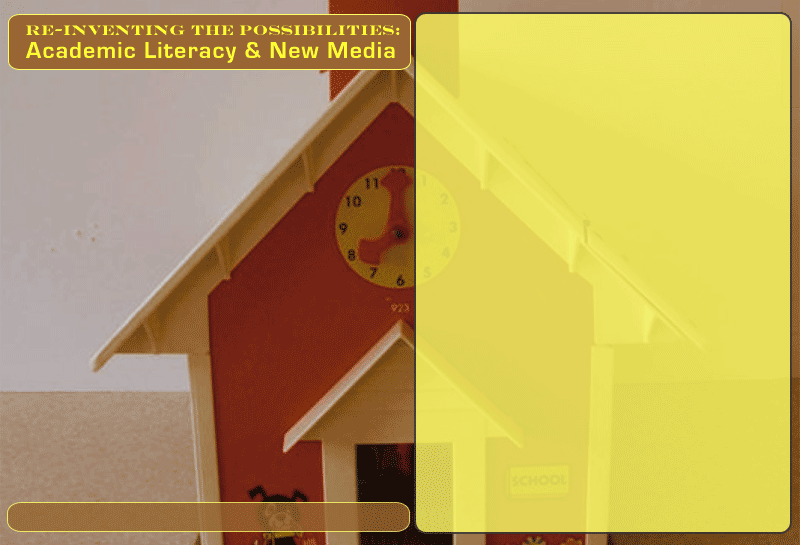A New Media University
As
we have shown in the comparison between
the WPA Council's statement on letteracy goals and new media literacy
goals, as well as in the first course/student description,
writing a research paper isn't the only possibility for students to
learn to think critically and compose a persuasive text with attention
to appropriate processes and conventions. Schroeder used oral and
written variants of academic literacies, and Sirc used written and
(found-)image-based variants to show critical learning.
Below we offer
a full-text draft of the WPA Outcomes updated to consider new media
literacies. We hope that readers will be able to see the subtle shifts and
to use these outcomes for the many kinds of assignments, including written
and new media ones, that students produce.
New Media Literacies Outcomes for General-Education Courses
(adopted from WPA Outcomes Statement for First-Year Composition)
Rhetorical Knowledge
By the end of first-year composition, students should
- Focus on a purpose
- Respond to the needs of different audiences
- Respond appropriately
to different kinds of rhetorical situations
- Use conventions of format and
structure appropriate to the rhetorical situation
- Adopt appropriate immediacy,
emotion, and interface
- Understand how genres shape interpretation and composition/production
- Compose
in several media
Faculty in all programs and departments can build on this preparation by
helping students learn
- The main features of composing in their fields
- The main uses of composing
in their fields
- The expectations of readers in their fields
Critical Thinking, Reading, and Writing
By the end of first year composition, students should
- Use composing and interpretation for inquiry, learning, thinking, and
communicating
- Understand a new media assignment as a series of tasks, including
finding, evaluating,
analyzing, and synthesizing appropriate primary and secondary materials
- Integrate
their own ideas with those of others
- Understand the relationships among modes
of communication (i.e., semiotic resources),
knowledge, and power
Faculty in all programs and departments can build on this preparation
by helping students learn
- The uses of composing as a critical thinking method
- The interactions among
critical thinking, critical reading, and composing
- The relationships among
modes of communication, knowledge, and power in their fields
Processes
By the end of first year composition, students should
- Be aware that it usually takes multiple drafts to create and complete
a successful text
- Develop flexible strategies for generating, revising, and
editing
- Understand composing as an open process that permits author–designers
to use later
invention and re-thinking to revise their work
- Understand the collaborative
and social aspects of composing processes
- Learn to critique their own and
others' works
- Learn to balance the advantages of relying on others with the
responsibility of doing
their part
- Use a variety of technologies to address a range of audiences
Faculty in all programs and departments can build on this preparation by
helping students learn
- To build final results in stages
- To review work-in-progress in collaborative
peer groups for purposes other than
editing
- To save revision for later parts of the composition process (after
initial, critical thinking
through compositional drafts has been done)
- To apply the technologies commonly used to research and communicate
within their
fields
Knowledge of Conventions
By the end of first year composition, students should
- Learn common formats for different kinds of texts
- Develop comparative knowledge
of linear textual and new media conventions, ranging
from the linear commonplaces of structure, paragraphing, and mechanics
to new media
commonplaces of interactivity, space+time, and link
- Practice media-appropriate
means of documenting their work (i.e., citations/references
or Ping/TrackBacks, tags, etc.)
- Control such surface features as accessibility,
usability, ethical designs, syntax, grammar,
punctuation, and spelling
Faculty in all programs and departments can build on this preparation by
helping students learn
- The conventions of accessibility, usability, ethical design, usage,
specialized vocabulary,
format, and documentation in their fields
- Strategies through which better understanding and application of media
can be achieved
In this webtext, we focus on digital
new media texts as a way to change the writing-based commonplaces
of general-education classes by introducing new media topoi
(the components of a text), thus opening Academic Literacy to
notions of composing beyond just writing, which can change the way
students engage in their learning processes within the university,
a new media university. In the next section, we turn to describing
how a graduate class—those who will eventually teach first-year composition
classes, if they aren't already—can enact similar literacies.
Go back to the
last node.
